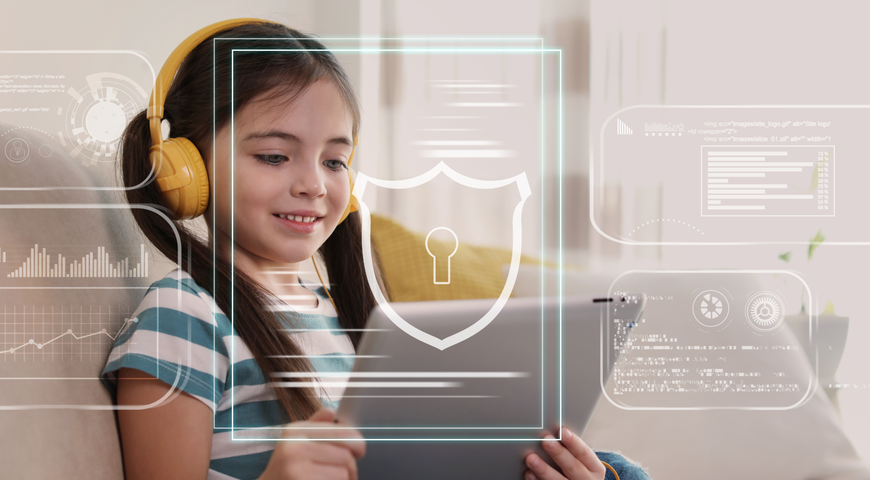
We are living in a world where technology is seamlessly integrated into every facet of our lives and ensuring the safety of our children in the online world has become an essential concern. The internet has undoubtedly revolutionized how we access information, communicate, and learn, offering unprecedented opportunities for growth and exploration. However, it also presents a lot of risks and challenges, particularly for young individuals who may be less equipped to navigate the complex landscape of the online realm.
Why is it important to protect your child online?
The concept of online safety for children extends far beyond just limiting screen time or installing parental controls. It encompasses a comprehensive approach that involves educating children about potential risks, fostering open communication, setting boundaries, and equipping them with the tools and knowledge to make responsible choices in their digital interactions. As children increasingly engage in online activities, such as social media, online gaming, and educational platforms, the need to establish a robust framework for their identity protection becomes even more critical. Because as parents we all hope for the best for our kids, and our desire is to keep them in a safe and friendly environment. But do we know enough about the potential risks waiting in the web storage? In this article, we will discuss all of the potential threats and how to protect your children online as much, as possible.
Statistics regarding online threats against children
The digital world is not without its perils, and the statistics are a stark reminder of the challenges that children face in the online realm. Cyberbullying, exposure to inappropriate content, online predators, and other threats have become disturbingly prevalent. The National Center for Missing and Exploited Children (NCMEC) reports a steady rise in cases related to online exploitation and child endangerment.
According to a survey conducted by the Pew Research Center, 59% of U.S. teens have experienced some form of online harassment, highlighting the pervasive nature of cyberbullying. Another study from the Crimes Against Children Research Center found that one in seven youngsters received unwanted sexual solicitations online, that fact is creepy and disgusting. These alarming figures underscore the urgent need for active protection measures to safeguard children's online experiences.
Awareness and Communication
Nowadays, to protect your children online it is essential to create awareness and promote dialogue regarding the risks present on the internet. To ensure their safety, we need to play a role in equipping them with the necessary understanding and resources to navigate the online environment responsibly. One key aspect is educating children about the significance of protecting their personal information.
Instilling the understanding that their child's personal information is a precious commodity and should be shared only with trusted individuals and sources helps to establish a foundation of caution. Encouraging them to be vigilant about the information they divulge on online accounts, social media sites, and chat rooms can fortify their defenses against potential threats.
Equally important is cultivating responsible online behavior at a young age. Teaching kids to think critically and question the authenticity of online information can help them discern between safe and risky online interactions. Nurturing a sense of digital citizenship involves encouraging children to treat others online with kindness and respect, mirroring the same values as they would in the physical world.
Engaging in open dialogue about the potential dangers they might encounter, such as interacting with strangers in chat rooms, can empower children to make informed decisions and report any uncomfortable experiences. By promoting a culture of awareness and communication, parents and guardians create a supportive environment where children can safely explore the digital realm while staying vigilant against online threats. It is our responsibility protecting children online and reveal all these scary aspects of their online activities, because the internet can be a very dangerous place.
The importance of educating children about online risks
Teaching kids to recognize and navigate potential dangers, such as interacting with strangers online, is akin to arming them with a protective shield. It is crucial to empower children with the understanding of how to differentiate between interactions and potential threats, like online predators or online bullies.
By having discussions about the importance of protecting information and the possible outcomes of sharing it with strangers, parents and educators can provide children with the necessary knowledge to make informed choices and remain cautious while navigating the digital realm.
Furthermore, instilling a sense of digital literacy and responsible online behavior from an early age can shape the way children engage with technology and how this process will reflect in the future. Teaching kids to be critical thinkers and encouraging them to question the authenticity of online information cultivates a healthy skepticism that can help them avoid falling victim to scams or misinformation.
Keeping your children safe online requires revealing to them strategies to handle online bullying, or harassment empowering them to seek help and report such incidents, and fostering a supportive kid's safe online environment. Ultimately, informing our kids about online risks isn't about instilling fear but rather about nurturing their ability to make safe and informed choices, thereby ensuring their digital experiences are enriching and secure.
Open and consistent communication with children regarding their online activities
Maintaining open and consistent communication with children about their online activities is a cornerstone of nurturing a safe and responsible digital presence. Engaging in conversations that talk openly about the benefits and potential risks of the online world allows parents to guide and support their kids effectively.
Establishing family rules and guidelines that teach kids about the importance of safeguarding personal details and adhering to responsible online behavior can lay a strong foundation for their online interactions. By involving children in discussions about setting boundaries and respecting privacy, parents can teach them to make thoughtful decisions while navigating the digital realm.
One crucial aspect of this communication is addressing the potential exposure to inappropriate content. Parents can initiate age-appropriate discussions about the types of content children may come across online and teach them how to handle such situations. Creating an atmosphere where kids feel at ease sharing their encounters and worries promotes trust and empowers parents to provide guidance in dealing with inappropriate content. By nurturing communication channels, parents can stay connected to their children's experiences, offer timely advice, and guarantee that their online activities are both educational and secure.
To Protect Your Child Online Set Up Parental Controls and Privacy settings.
Keeping your child safe online involves establishing controls and privacy settings. By adjusting the security settings on devices and platforms, we as parents can have a level of influence over the content and interactions that our children come across. Initiating an open conversation with our children about these measures is equally vital.
Talking openly about the reasons behind setting up parental controls and the family rules in place helps children understand the importance of online safety and the boundaries established to protect them. Teaching kids about personal details and the significance of keeping sensitive information private further enhances their awareness of potential online risks.
In addition to parental controls, utilizing security software can provide an added layer of protection. Installing reputable security software can help filter out harmful content, monitor online activities, and prevent unauthorized access. A few tips for all of the parents include staying informed about the latest security features offered by devices and platforms, regularly reviewing and adjusting privacy settings, and staying engaged in ongoing conversations with their children about their online experiences. By combining parental controls, privacy settings, and open communication, parents can effectively create a digital space where their children can explore and learn while enjoying a safe and secure online journey.
What are the benefits of parental control software?
Parental control software offers a variety of advantages for modern families striving to create a secure and nurturing online environment. With the ever-expanding digital landscape, these tools provide an invaluable means to establish and maintain effective security settings tailored to each child's age and maturity. Many parents find solace in knowing that such software acts as a virtual guardian, enabling them to set ground rules and enforce limitations on the types of content their children can access. This not only helps shield young minds from accessing inappropriate content or harmful material, but also cultivates a sense of responsible online behavior from an early age.
Another significant benefit lies in the opportunity for parents to actively engage in open discussions about internet safety. Parental control software serves as a catalyst for dialogues about the importance of adhering to established rules and understanding the rationale behind these measures. By involving children in the decision-making process and explaining the purpose of the security settings, parents foster a sense of responsibility and accountability.
Moreover, these tools offer peace of mind, enabling parents to strike a balance between allowing their children to explore the digital realm and ensuring their safety. As children learn to navigate the online landscape with the guidance of parental control software, they develop essential skills for being safe online and gain the confidence to seek help from a trusted adult whenever they encounter unfamiliar or uncomfortable situations. In this way, parental control software not only keeps children safe online, but also empowers them to become responsible digital citizens.
How to install and configure parental controls on different devices?
Installing and configuring parental controls on different devices is a proactive step towards keeping your child safe online and ensuring their digital experiences align with the family values. When it comes to mobile devices, each platform offers specific methods to establish and customize these safeguards. For smartphones and tablets, parents can explore the device's settings to locate the parental controls section.
Here, they can often set restrictions on app downloads, limit online access during specific hours, and even filter out inappropriate content. By enabling these controls, parents can strike a balance between granting their children the benefits of mobile technology while implementing online safety tips that shield them from potential risks.
For computers, both Windows and macOS operating systems come equipped with built-in parental control features. These allow parents to manage web browsing, set time limits for online activities, and monitor usage patterns. On popular web browsers, extensions and add-ons can be installed to further enhance parental controls, providing options to block specific websites or filter search results.
Additionally, gaming consoles offer parental control settings that limit gameplay time, restrict access to certain games based on age ratings, and prevent interactions with strangers during online gaming sessions. By delving into the settings of each device, parents can tailor the level of control to suit their children's needs and developmental stages, thus ensuring a safer and more enriching digital experience.
Social media platforms' privacy settings and how to adjust them
Social media platforms privacy settings play a pivotal role in protecting children online in the increased online presence and ensuring their digital experiences remain secure. As kids online are drawn to social networking sites and interact with others through their mobile devices, it becomes crucial for the parents to be well-versed in adjusting these settings to create a protective digital environment.
Explaining the age limits associated with different platforms is a crucial starting point, because there is a lot of inappropriate content in all the sites and games. Many social media platforms have minimum age requirements to sign up, which are designed to protect younger users from potential risks and inappropriate content. Parents can engage in meaningful conversations with their children about these age restrictions and the reasons behind them, promoting an understanding of responsible online behavior.
To adjust privacy settings for child's personal information on social media platforms, parents can guide their children through the process step by step. Begin by accessing the account settings, where options to control who can view posts, send friend requests, or access personal information are often available. Teach children to set these options to "friends only" or "private" to restrict access to their posts and details.
Additionally, instruct them to carefully review and manage their friend list, ensuring they only connect with individuals they know and trust in real life. On mobile devices, installing social media apps with built-in privacy controls can offer an added layer of security. Regularly reviewing and updating these settings, along with encouraging open communication about online experiences, empowers children to navigate social media platforms safely and responsibly, contributing to a positive and secure digital presence.
Teach Online Safety practices.
Teaching online safety practices is an essential responsibility in today's digital realm, especially as kids interact with various platforms, including social networking sites. Parents and educators play a crucial role in imparting valuable knowledge about the intricacies of safe online interactions. Clarifying the reasons behind these restrictions helps children understand the importance of adhering to them and fosters a sense of responsible online behavior from an early age.
Engaging children in discussions about safety features provided by different platforms is equally vital. Educate them about the significance of utilizing privacy settings to control who can access their information and posts. Emphasize the importance of reporting any instances of online bullying or inappropriate content, fostering a culture of empowerment and accountability.
Encourage open conversations about their online experiences, ensuring children feel comfortable sharing concerns and seeking guidance whenever needed. By imparting these online safety practices, parents equip children with the tools to navigate the digital world confidently while fostering a respectful and secure online environment.
Educating children about strong and unique passwords
Informing your children about the importance of strong and unique passwords is an indispensable component of their digital literacy journey. As children engage in various online activities, such as internet use, online purchases, and social interactions, understanding the significance of password security becomes paramount. One fundamental principle to emphasize is the avoidance of using a default password. Default passwords, often set by manufacturers or platforms, can be easily exploited by cybercriminals seeking unauthorized access to personal accounts. By teaching children to replace default passwords with their own, a critical step towards enhancing online security is taken.
Furthermore, instilling the practice of creating strong and unique passwords helps shield children's personal information, including personal details or school projects, from potential breaches. Encourage them to craft passwords that combine a mix of uppercase and lowercase letters, numbers, and symbols while avoiding easily guessable information, such as birth dates or names. Stressing the importance of using different passwords for different online accounts is equally vital.
To ensure that if one account is ever compromised, it doesn't give cyber criminals access to other accounts, it's important to teach children about password security. By giving them this knowledge, parents empower them to use the internet securely and responsibly, protecting their online activity and personal information from potential dangers.
Understanding and avoiding phishing attempts
Understanding and effectively avoiding phishing attempts is a crucial skill in today's interconnected digital realm, where our kids engage in diverse online activities across various devices. One common method that cybercriminals employ is the use of deceptive pop-ups. These seemingly innocuous windows may prompt users to enter personal information, often in the guise of urgent messages or enticing offers.
Teaching our kids, especially children who are active on online devices like mobile phones, to exercise caution and never provide personal information in response to pop-ups is paramount. Encouraging skepticism and the habit of verifying the legitimacy of such requests can thwart potential phishing attacks and safeguard sensitive information.
Children, who may be particularly vulnerable to online predators, can greatly benefit from understanding the concept of phishing and recognizing the tactics used by malicious actors. By fostering a comprehensive understanding of phishing attempts and nurturing a discerning approach to online interactions, kids can cultivate a safer online experience across their various online activities and devices.
Recognizing and reporting suspicious behavior or content
Recognizing and promptly reporting suspicious behavior or content is a critical aspect of keeping children safe online as they engage in various activities across different online devices. As kids immerse themselves in the digital realm, particularly in online games and other forms of online activity, educating them about the importance of vigilance is essential.
One particular concern is the presence of predators on the internet. These individuals may take advantage of games and other platforms to target children. It is crucial to teach kids how to recognize signs of behavior, such as when someone asks for information or an online predator tries to arrange an in-person meeting. By doing this, we can provide our children with the tools they need to identify threats and take proper actions to restrict them.
It's important for children to understand that they should report any incidents like these to a trusted adult, whether it's a parent, teacher, or another authority figure. This approach encourages a sense of responsibility and accountability among children, ensuring that they actively participate in their safety. By nurturing this awareness and cultivating a culture of reporting, parents and educators contribute to a safer digital environment where children can explore, learn, and communicate while avoiding potential risks, such as identity theft or interactions with toxic individuals.
Limit Screen Time and Establish Technology-Free zones.
Limiting screen time and creating designated technology-free zones at home are essential strategies for promoting a healthy and balanced lifestyle, especially in a world where mobile phones and other devices are ubiquitous. Nowadays, a lot of parents understand the significance of setting boundaries on the amount of time kids spend in front of screens.
It's important for children to have a range of activities beyond digital interactions. By establishing rules about when and how long devices can be used, parents can encourage their children to explore their interests, engage in physical activities, and interact with the world around them. Additionally, involving kids in conversations about screen time limits helps them develop a sense of responsibility and self-control, empowering them to make decisions regarding their use of technology.
Creating technology-free zones within the home further supports the goal of achieving a harmonious balance between digital engagement and offline experiences. These designated spaces, such as the dining room or bedrooms, provide opportunities for genuine human interactions and quality family time without the distractions of screens.
Just as other parents have discovered, having specific areas where devices are not allowed cultivates an environment where meaningful conversations and bonding can flourish. This approach reinforces the idea that there is a time and place for technology while also nurturing the development of interpersonal skills and promoting mental well-being. By incorporating these practices, families can effectively manage screen time, encourage holistic growth, and forge deeper connections among family members in today's digital age.
Creating tech-free zones within the home, such as during meals or before bedtime
In the midst of our fast-paced digital lives, creating tech-free zones within the home has emerged as a valuable practice to foster meaningful human interactions and promote overall well-being. Designating specific times, such as during meals or before bedtime, as moments free from the intrusion of mobile devices and screens, offers a sanctuary where family members can connect, engage in genuine conversations, and truly savor the present moment.
By setting boundaries around mealtimes, families can relish in shared culinary experiences without the distractions of checking notifications or feeling the urge to post online. This simple yet impactful practice promotes a sense of togetherness and mindfulness, allowing everyone to unwind and engage in unhurried, face-to-face conversations.
The hours leading up to bedtime provide another opportune moment to establish a tech-free zone. Encouraging the habit of putting away mobile phones and avoiding screens before sleep can significantly improve sleep quality and promote a peaceful transition into restful slumber. As research shows, the blue light emitted by screens can disrupt the body's natural sleep-wake cycle, making it harder to fall asleep.
By designating a technology-free period before bedtime, kids can engage in calming activities such as reading, reflecting, or engaging in gentle stretches, all of which contribute to a more restorative and rejuvenating night's sleep. Embracing tech-free zones during these crucial times not only nurtures deeper connections and quality rest but also reinforces the importance of balance in our increasingly digitally connected lives.
Encourage Responsible Social Media Usage
Encouraging responsible social media usage among your kids is a fundamental aspect of nurturing their digital well-being. As kids increasingly engage in online activities and manage their own online accounts, guiding them towards a thoughtful approach to social media is essential. Emphasize the significance of maintaining a positive online reputation, reminding them that the content they share can have lasting effects on their digital identity.
Teach them the value of being mindful about the information they post, the photos they share, and the interactions they engage in, as these aspects collectively contribute to shaping their online presence. By instilling the importance of responsible social media usage from an early age, parents can empower their children to navigate the digital landscape with awareness, integrity, and a sense of digital citizenship.
Discussing the potential consequences of oversharing personal information online
Engaging in conversations, with your children regarding the consequences of sharing too much personal information online is a vital step in their digital education. By discussing the risks associated with revealing details like their location, school or identifiable information parents can help their kids grasp the importance of protecting their privacy.
Emphasize that not everyone they encounter on the internet may have intentions and talk about the dangers of coming across an online predator who could exploit their child's personal data. Empower your children by educating them about being cautious with what they share and who they interact with online, as this plays a role in online behavior and ensures they navigate the digital world confidently and securely.
Promoting good digital citizenship and respectful behavior on social media platforms
Promoting good digital citizenship and fostering respectful behavior on social media platforms is a cornerstone of guiding our children's online interactions. By explaining the significance of treating others with kindness and empathy, parents can help their kids navigate the complexities of virtual relationships. Encourage your children to think before they post anything, comment, or engage in direct messaging, reminding them that their words can impact others in different ways.
Discuss the potential consequences of inappropriate behavior, emphasizing the importance of maintaining a safe and respectful online environment with their friends. By instilling these values, parents empower their children to contribute positively to the digital community they are part of, ensuring that their online interactions mirror the same respect and consideration they would demonstrate in face-to-face interactions.
Monitor Online activities
Monitoring the online activities of your kids is a responsible approach to ensuring their safety and well-being in the digital realm and their everyday connections with others. As a proactive step, parents can collaborate with their internet service provider to implement parental controls that limit access to inappropriate content and establish boundaries for online access.
Regularly reviewing their kids online interactions, the websites they visit, and the apps they use allows parents to identify potential risks and initiate constructive conversations about responsible internet use. By maintaining an open and supportive dialogue and explain age limits for current websites, parents can strike a balance between protecting their children and fostering their autonomy, ultimately creating a secure and enriching online environment where kids can explore and learn while staying safe.
Balancing trust and supervision when it comes to online activities
Striking a delicate balance between trust and supervision is essential when guiding your child's online activities. While fostering a sense of autonomy is crucial, it's equally important to prioritize their internet safety, but on the other hand understand their desires and keeping their comfort zone. Engaging in open conversations about the potential risks associated with sharing personal information online helps children understand the importance of safeguarding their identity.
By setting clear guidelines and periodically checking their online interactions, parents can ensure a safe digital experience without stifling their child's exploration. This balance encourages responsible online behavior that mirrors real-life interactions, empowering kids to make informed choices while navigating the vast online realm.
Stay Updated on the Latest Online threats
Staying updated on the latest online threats is fundamental when it comes to protect your kids in the digital realm. As technology evolves, new challenges and threats may arise on a daily basis, making it essential for parents to stay informed about potential risks that could affect their children's internet safety. Regularly checking for news and updates on online security, particularly related to mobile phones, online accounts, and instant messaging programs, empowers parents to stay one step ahead of potential dangers and ensure their kids have a better online environment.
By remaining vigilant and educated, parents can effectively guide their children on how to navigate the digital world safely while also imparting valuable lessons about responsible online behavior and the importance of staying cautious in a rapidly changing online landscape.
Advocating for schools and community organizations to provide resources and workshops on online safety
It is crucial for schools and community organizations to prioritize the provision of resources and interactive workshops on safe web usage. This ensures that every child is prepared to navigate the web world with the growing integration of online learning, and the use of platforms becomes essential for schools to actively educate students about risks and effective practices to safeguard their online accounts.
By partnering with community organizations, parents can contribute to building an environment where children can acquire skills such as identifying online threats and understanding the significance of privacy settings. These resources and workshops offer tools that empower individuals to make informed decisions while interacting online. This fosters a culture of responsibility, ultimately contributing to a more secure online experience for everyone involved.
Cyberbullying Prevention and Intervention
It is important to be proactive in preventing cyberbullying and intervening effectively to keep your children safe in today's digital era. As kids engage with their friends, both offline and online, it is vital to promote a culture that values respect and empathy. Engage in discussions about the dangers of cyberbullying, emphasizing the significance of treating others with kindness regardless of whether they have met online or in person.
Inform and encourage your kids to be vigilant and speak up if they witness or experience any form of online harassment. Equipping them with strategies to report and block harmful behavior can empower them to navigate the digital realm confidently. By instilling a strong sense of empathy and responsibility, parents can play a pivotal role in creating a safe and supportive online environment where kids can explore, connect, and learn while treating others with dignity and compassion.
Steps to take if a child becomes a victim of cyberbullying
If a child falls victim to cyberbullying, it is crucial to take supportive action. Start by providing a non-judgmental space for them to express their experiences and emotions. Encourage them to gather evidence of the cyberbullying, such as screenshots or messages, as this can be vital when reporting and seeking intervention. Reach out to the platform or website to report the behavior and ask for assistance in removing harmful content.
In persistent cases of cyberbullying involving school authorities, or law enforcement might become necessary. Let your child know that they are not alone, and assure them that you will tackle the situation together. Offer support while guiding them towards online interactions, which can help restore their sense of security and confidence in their online experiences.
Promoting a positive and inclusive online environment
Creating a positive and inclusive environment for your children involves instilling values like empathy, respect, and responsible behavior in their interactions across various digital platforms. Encourage them to view their devices and online accounts as tools for building connections and making a positive impact on online communities.
Teach them the importance of treating others with kindness, both online and offline. Guide them on how to navigate conflicts or disagreements in a positive way. By emphasizing the significance of manners and helping them understand the consequences of their words and actions, parents can empower their kids to shape a space that mirrors the inclusive and compassionate values they adhere to in their everyday lives.
Conclusion
Nowadays, every child has a computer, mobile phone, and other smart devices around. We live in a world where digital technologies are constantly upgrading. It is not a bad thing that every kid has a smartphone in his pocket or a computer at home, but teaching our kids about the potential risks out there is essential to maintaining their mental health. As parents, we all know what kind of dangers can hide behind the screens, and it is our responsibility to educate them not only about the risks but also to be kind and empathic around the web.
Thus, we will make them more comfortable while browsing the internet, communicating, or playing games with friends. Every parent should explain that nowadays, technologies are good but need attention because of the potential risks they hide. By doing so, a child can become a responsible adult.
About Acronis
A Swiss company founded in Singapore in 2003, Acronis has 15 offices worldwide and employees in 50+ countries. Acronis Cyber Protect Cloud is available in 26 languages in 150 countries and is used by over 20,000 service providers to protect over 750,000 businesses.




